The KIT locus appears to be affected by many mutations and is thought to be responsible for several different white patterns.
NOTE: Unless all KIT alleles are tested for (even the ones that can't be found in your horse's breed), wrong KIT results may display. Once the horse profiles move to V2, we will be able to fix this bug completely.
In real life, KIT is in a linkage group with the extension gene, but this is NOT a feature in Horse Reality. Linked genes are located close together on a chromosome. The closer together genes are physically, the more likely they are to be passed on together as a unit, rather than independently in different combinations. This means that if a horse is E/e SB1/n, for example, it would only pass on either E + SB1 or e + n. The E-allele and the SB1-allele are located next to each other on the same chromosome and therefore are passed on together. Passing on e + SB1 or E + n would be very unlikely. On rare occasions, a “crossing over” event can happen, where the alleles do get recombined and, for example, e + SB1 is passed on after all. In real life, this phenomenon of linked genes can affect the usual predictions of possible foal coat colours. It could also cause certain combinations of colours to be more rare than others - for example, if the E-allele were linked to the SB1-allele, chestnut-based sabino1 horses would be a lot rarer than black or bay-based ones.
¶ Tobiano
The tobiano white pattern, also referred to as piebald (black and white) or skewbald (other colours and white) in the UK, is caused by a chromosome inversion very close to the KIT locus. Since it is located so close to KIT and likely also interrupts its function, tobiano is usually treated as being part of KIT.
Tobiano has a rather vertical expression. It creates white legs below the hocks and knees. In minimally expressed tobianos, this can be the only white they have. Tobiano can also be characterised by white, rounded patches on the coat that typically cross the topline (back) of the horse somewhere between the ears and tail. It generally doesn't create markings on the head.
The tobiano allele (TO) is dominant. There may be some visual differences between horses that are heterozygous (TO/n) or homozygous (TO/TO) for tobiano; small, coloured spots within the white patches called paw prints, ink spots, or cat tracks are typical for horses homozygous for tobiano, but exceptions are possible. Genetic testing remains the most reliable method to distinguish the two.
| Tobiano - Irish Cob Horse | ||

|
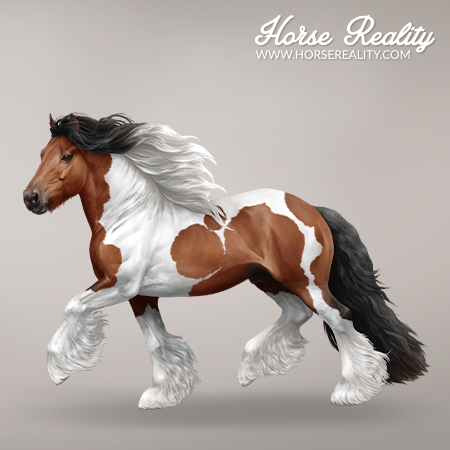
|
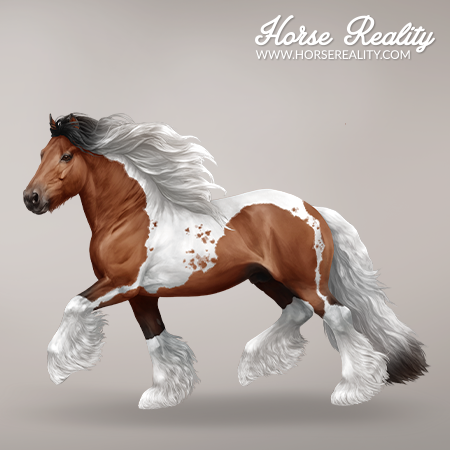
|
Below, the resulting phenotype of each genotype is listed:
- TO/TO = Tobiano
- TO/n = Tobiano
- n/n = Not tobiano
Tobiano can be tested at the Laboratory.
¶ Sabino1
Sabino1 is characterised by white markings on the legs, often accompanied by white patches on the horse's belly, face and/or entire body. The edges of these markings are typically irregular and jagged. White ticking on the body is also very common. There is a high variability of expression: it can be very minimal and difficult to distinguish from regular white markings, or even cause the horse to look almost entirely “white”.
Sabino1 is caused by the incomplete dominant SB1-allele. Horses heterozygous for SB1 have less white than horses that are homozygous, who often look nearly “white”.
| Sabino1 - Irish Cob Horse | |

|
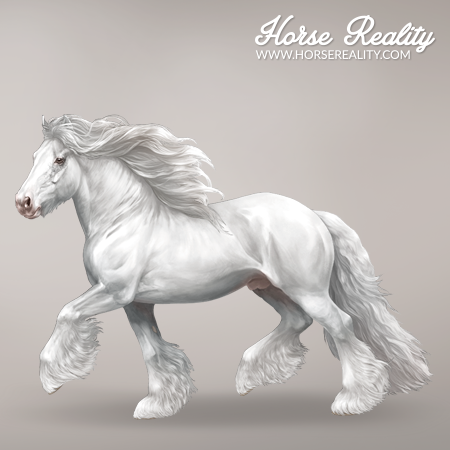
|
Below, the resulting phenotype of each genotype is listed:
- SB1/SB1 = Sabino1
- SB1/n = Sabino1
- n/n = Not sabino1
Sabino1 can be tested at the Laboratory.
¶ Roan
Roan is characterised by white hairs mixed into the rest of the coat except for the head, lower legs, manes, and tail, which usually stay entirely coloured. The coloured head and the “inverted V's” on the legs are important characteristics of roan: Where the roan meets the coloured lower legs, an upside-down-V-shaped border can be seen. The exact mutation responsible for roan hasn't been discovered yet in real life, but it has been assigned to the KIT locus.
Foals are born with the coat colour determined by their genes, without white hairs. The roan pattern usually becomes visible as the foals start their first shedding. In Horse Reality, foals will be born without any visible roan and show a roan coat once they turn into an adult (3 years old), which they keep for the rest of their life without any changes.
| Roan - Various breeds | |

|

|
Roan is caused by the dominant RN-allele. Homozygous (RN/RN) and heterozygous roans (RN/n) are identical in appearance. In Horse Reality, roan can be tested accurately at the Laboratory.
Below, the resulting phenotype of each genotype is listed:
- RN/RN = Roan
- RN/n = Roan
- n/n = Not roan
¶ White Spotting
White spotting is a general name given to a large group of related white patterns. Currently, 34 different variations have been discovered in real life. At the moment, only W3, W10, W19, W20 and W21 have been implemented in-game.
There is a large variability in the type of pattern and amount of white caused by each of the different variations. The expression may vary from leg and face markings with or without white patches on the belly, to even a nearly “white” phenotype. The white markings and patches often have irregular, jagged edges. White ticking on the body is also quite common.
| White spotting - Various breeds | |

|
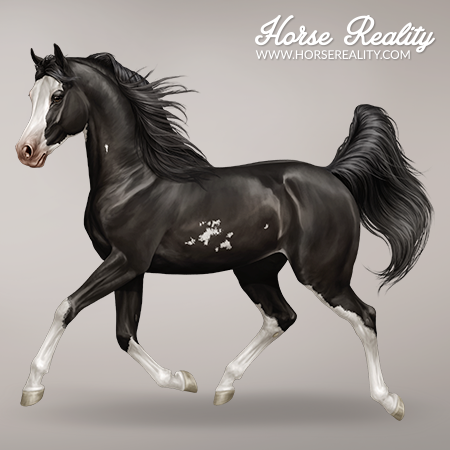
|
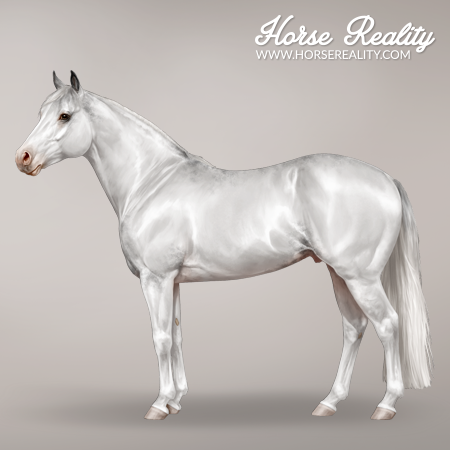
|
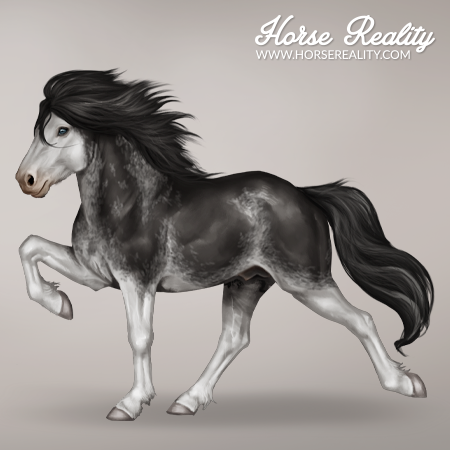
|
At the moment, only homozygous W20 (W20/W20) is viable. Breeding two horses together that both have any of the other white spotting alleles (Wx/n), will result in a failed pregnancy on the 4th day if the foal is Wx/Wx (25% chance). By now there is proof that certain white spotting combinations are viable when homozygous, but at the time of game code implementation, this was not yet known.
A table (Punnett square) with possible genotypes and their results when breeding is below:
| W20 | Wx | n | |
|---|---|---|---|
| W20 | W20/W20 Foal with W20 |
/ | W20/n Foal with W20 |
| Wx | / | Wx/Wx Failed pregnancy |
Wx/n Foal with white spotting |
| n | W20/n Foal with W20 |
Wx/n Foal with white spotting |
n/n Foal without white spotting |
¶ Combinations of KIT alleles
Since a horse only has 2 copies of each gene, it would be expected that a horse can therefore also only have 2 KIT alleles. This is the case in Horse Reality.
The possible KIT genotypes are listed below:
- TO/RN = Tobiano roan
- TO/SB1 = Tobiano sabino1
- TO/Wx = Tobiano white spotting x
- RN/SB1 = Roan sabino1
- RN/Wx = Roan white spotting x
- SB1/Wx = Sabino1 white spotting x
However, in real life, there have been examples of horses that carry 2 KIT mutations on the same chromosome! The KIT locus is quite large, and the mutations causing the different white patterns are often located at different places within or close to it. Therefore, a very rare recombination event like mentioned above could result in a horse that has a KIT locus with multiple mutations on it. It is also possible for a new KIT mutation to occur on a chromosome that already had a different one before.
| Combinations of KIT alleles - Irish Cob Horse | |

|
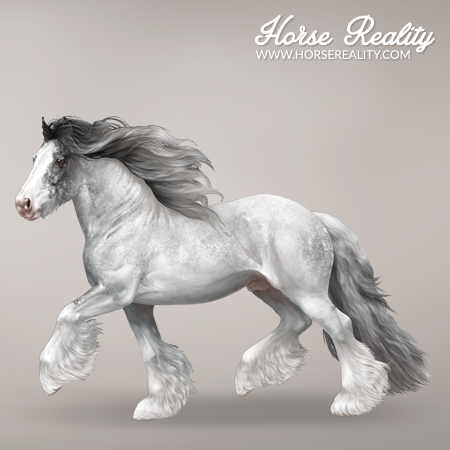
|
KIT mutations can also be present together with other white patterns, such as frame overo or splashed white 1. When a horse has multiple (KIT) white patterns, they usually combine the characteristics of the patterns that are present and generally have more white than the individual patterns would cause. Horses that have both tobiano and another white pattern are often called “tovero”.
¶ References
- Bellone R., Sponenberg D. P., Equine Color Genetics, 4th Edition, 2017, Wiley-Blackwell
- Bowling A, Ruvinsky A., 2000, The Genetics of the Horse, 2000
- UC Davis Veterinary Genetics Laboratory; https://vgl.ucdavis.edu/test/tobiano, https://vgl.ucdavis.edu/test/roan, https://vgl.ucdavis.edu/test/sabino-1, https://vgl.ucdavis.edu/test/dominant-white-horse; Access: December 2022
- Generatio Center for Animal Genetics; https://generatio.de/en/guidance/lexicon/tobiano-horse, https://generatio.de/en/guidance/lexicon/sabino-1-coat-colour-pattern-horse, https://generatio.de/en/guidance/lexicon/white-spotting-horse; Access: December 2022
- The University of Sydney, Online Mendelian Inheritance in Animals (OMIA); https://omia.org/OMIA000209/9796/; Access: December 2022